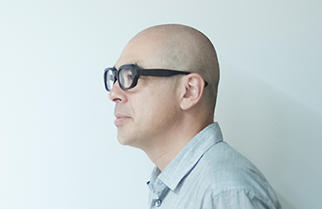
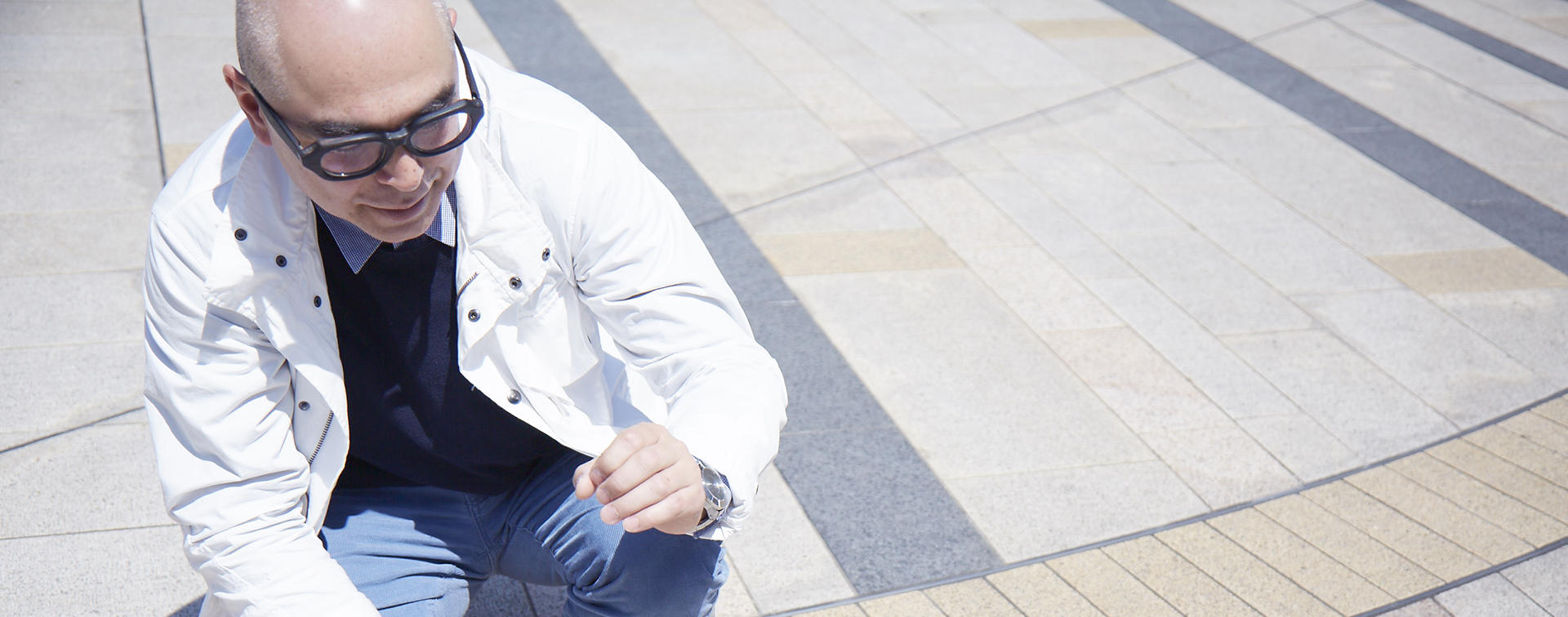
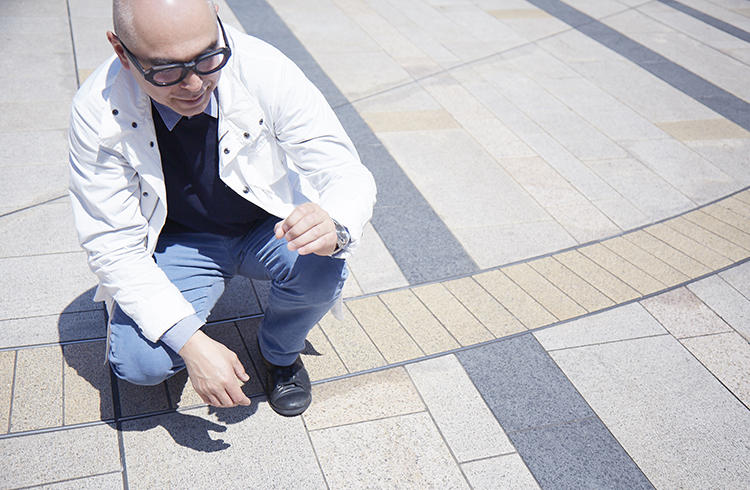
The colors of streets and the process of making things
A Roppongi event for wearing checkered clothes
Creative director Dai Fujiwara has worked on projects such as "MUJI to GO" and Shiseido's "LINK OF LIFE" while also teaching at universities. In 2014, Fujiwara was guide for a special tour organized by Roppongi Future Talks of the "Color-hunting" exhibition. In this interview, he talked about Roppongi seen from the perspective of colors, and also about the process of making things.
Corporate, academic and regional projects
The work I usually do can be divided into three categories - corporate, academic and regional. "Corporate" refers to company projects like the "MUJI to GO" project which I am directing. "Academic" means educational work such as teaching at Tama Art University. "Regional" refers to the various projects for towns and neighborhoods such as Roppongi Future Talks.
In the last five years, I've been putting my energies into academic and regional work. For example, in 2012 when I set up my own office, I launched a project in the Shonan area called "Inter Travel Design Forum." To promote consumption of local produce we've done things like holding workshops on Kamakura vegetables; we've also collaborated with students and held an exhibition in the underground passage of JR Kamakura Station. A project is currently underway to link Enoden (Enoshima Electric Railway) with the local shopping district.
The other day, there was a festive event for the Dankazura pedestrian path at Tsurugaoka Hachimangu in Kamakura, and we made an offering to the shrine of a flag made from bamboo and washi. I'm interested in the handcraft of the Kamakura period and I'm planning events so that people can try making things made in that period.
I'm also involved in a project for Shiseido called "LINK OF LIFE". We held an exhibition in 2015. The project is about connection, and we are linking scientists and researchers, designers and artists, as well as the establishment owners in the shopping districts. We will hold an exhibition in Ginza this year too. It will be in October during Tokyo Design Week. Since Ginza is close to Roppongi, it would be great if we could get together with Roppongi Future Talks and do a related project.
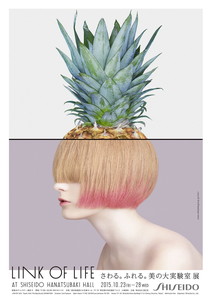
LINK OF LIFE exhibition
Shiseido's exhibition directed by Dai Fujiwara, consisting of collaborative works made by researchers and creators in and outside of Shiseido. Shiseido calls it "a grand laboratory of beauty where science, technology, engineering and art are linked together by design." An exhibition themed on the sense of touch was held in October 2015.
Roppongi - a place that helped me grow
I know quite a lot about Roppongi - it's a place that helped make me to grow in a way. My hometown is in the Shonan area, but I did part-time jobs here during my high school and college days, and I went home every night on the last train. So I have many memories of Roppongi. There were some establishments where the people were really kind; it was such fun to be paid for doing work where I could meet and talk to people. I spent my time in all kinds of places.
I don't really know why I decided to work in Roppongi, but I enjoyed coming here and absorbing the atmosphere. I think there must be a magnetic field in Roppongi and I was probably drawn by some kind of animal instinct. (laughs)
My ties to Roppongi continued after I started working,: I was given the opportunity to hold the "Color-hunting" exhibition at 21_21 DESIGN SIGHT, and the Miyake Issey exhibition is currently being held at the National Art Center, Tokyo. Of course, I've made a visit to that exhibition. It shows the marvelous creativity of the Miyake Issey team and one can get a comprehensive view of Issey-san's works. I think it's an awesome exhibition.
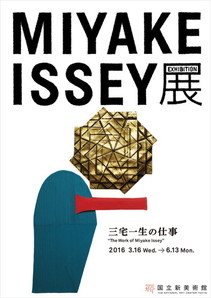
MIYAKE ISSEY EXHIBITION: The Work of Miyake Issey
A retrospective exhibition showing the creations of Miyake Issey in his roughly 45-year career that began in 1970. Taku Satoh designed the exhibition venue, while Tokujin Yoshioka designed the interior and torso mannequins. Opened on March 16, 2016 the exhibition will be held until June 13.
A place that transmits new things in an easy-to-understand way
In the past, there were many attractive spots in Roppongi with high-tech atmospheres where interesting people would gather. Roppongi was a place to look at new things, to hear about new things, and to talk about new things; people came here to communicate and connect.
Ropponigi has always been a place with many foreigners and it has very international elements. In the old days, most people came here at night. The nightlife of Roppongi had a strong impact on the culture. It wasn't just about imbibing alcohol - people had meals, had drinks, talked and danced, and a culture was created from this physical aspect. I think Roppongi is an uplifting place with literacy. It has the capacity to absorb new things and it also understands the necessity of transmitting these new things in a way that is easy to understand. Now there are a lot of art museums here. Art museums are not nighttime places but they have the same function as nightlife. I guess you could say that daytime and nighttime are finally getting linked in Roppongi.
Adults can indulge in fun in cities like London and Paris because these places have a flexible stance and are accepting of outside cultures. Although it's true that these places which are trying to embrace diversity, are facing complex problems recently.

People need places to meet and connect
It's a bit sad that the culture that was created in Roppongi moved to places like Shibuya and Shinjuku due to reason of space and function. The things that were cultivated during Roppongi nights and caught the imagination of people have been developed in other areas. And the Internet has become the substitute for the communication and connection that existed in Roppongi. But recently, when I talk to people, I get the sense that people are again beginning to be interested in physical places - they want to hold idle conversations and be connected to others.
I sometimes feel that Tokyo is like a human body. A certain town is like the heart, while another town is like the liver and another is like the pancreas; all the different areas are like body organs. So Ginza and Roppongi have different functions within the body. We shouldn't try to make one area be simultaneously heart, liver and pancreas. If you look at Tokyo in that way, I think you will be able to see how Roppongi is viewed from the outside, and what sort role of Roppongi should play. It's better not to be everything at the same time; a shop selling mochi (rice cakes) ought to be content with selling nothing but mochi.
Checkered patterns in all kinds of colors
If Roppongi were to be expressed in colors, I think it would be many blocks of different colors. By that, I don't mean a dozen of loud colors, but a sort of mosaic of many colors in various tones. Compared to the past, Roppongi has lost its chaotic feel, but there are still many colors which make it an intriguing place.
I have an idea for transforming the streets through fashion: how about having a day where everyone wears checkered clothing of different colors? On Saint Patrick's Day which is a Christian festival, people wear green clothes and eat green food. In a similar way, the people of Roppongi could wear checkered clothes and visitors could be asked to come wearing checkered clothes or to purchase them. It could be a small item of clothing like a stole or a hat, or even a handkerchief, or a metal badge. And perhaps we could have those checkered patterns for the packages of pocket tissues that are given out to pedestrians. Shop windows could be decorated with checkered sheets.
I think the "ichimatsu" patterns are the nicest, but using checkered fabric will be costly, so maybe you could use bordered or striped cloth instead. If you're not fussy about that kind of thing, you could use printed textiles. Or maybe you could use paper instead of fabric. You can do so much with paper - there are now bags and clothes made wholly from paper. Whatever material or pattern you use, the important thing is having a story. If you could get together and think of a good story, then people will be persuaded to participate.
A society that consumes less things
When making things, I involve myself with the whole process - from creating the materials to seeing how the end product is used. That's always been my stance. With the "A-POC" project, we used digital technology to make clothes. My approach of blending science and design will remain unchanged in the future. The IoT (Internet of Things) has evolved considerably, and I'm currently figuring out ways to speedily make fabric products while at the same time giving thought to how they will be actually used.
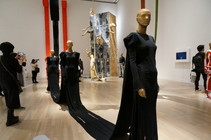
A-POC
A project launched in 1998 by Issey Miyake and Dai Fujiwara for computer-designed clothes that can be cut out from a tube of material. The first works were shown at the 1999 spring-summer Issey Miyake Paris Collection. A-POC has won Good Design Grand Award in 2000 and the Mainichi Design Prize in 2003.
It's often said that in the future, society will consume less things, but I don't believe that's true. We're in a period of transition now where people are being divided into two groups - the former buys things and consumes them and the latter doesn't. I guess the non-buying group will increasingly get bigger. After all, you can relax when you have only a few things - management is easier and it's convenient. For example, when you want to hold a party, you can get catering, and the rooms look cool when they are barely furnished.
It will be the economically independent people who will stop buying things. They will be buying services instead. Ultimately, things that are not linked to some sort of service will not sell. That's a bit discouraging for people like me who make things, but I comfort myself by thinking that making things means providing services. (laughs)
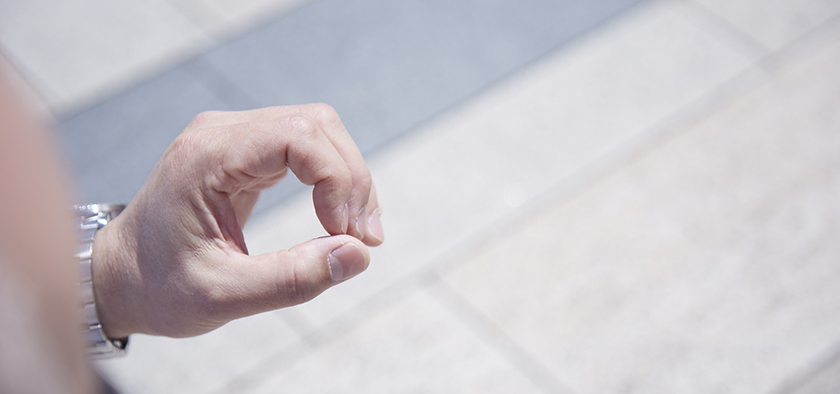
Looking at the present to understand the future
You ask me what the future of manufacturing will be like - I wish someone would tell me the answer to that question. (laughs) One thing I feel sure about is that we need to create new values by cleaning up and collecting waste. I myself am not particularly good at separating garbage, but as a shift occurs in consumption from things to services, I'm worried that people might become less aware of how they dispose of things.
I'm going off track a bit, but people don't make nukazuke (pickles made by fermenting vegetables in rice bran) these days, do they? To make nukazuke, you have to buy cucumbers and wash them clean, and mix the nukadoko (rice bran bed) every day, and then your hands become smelly from mixing. People who don't make nukazuke don't know about those details though. When you don't have the experience, your appreciation becomes limited and people's values become standardized. This is what happens when people buy services instead of things.
To make things, you need to know about the nature of the materials that are used. Physicality is needed in design. I think new values are more likely to be born from physical things and that it's in the physical realm that creative challenges can be taken. This might seem a strange thing to say, but I think the waste that comes from used things is an issue that concerns everyone and brings us together. I feel that when you are not involved with the garbage in everyday life, you fail to have a deep understanding for making things.
The Japanese have the DNA for making things. Or you could say it's our memes that have been passed on for hundreds of years. In the Edo period, about 300-400 years ago, the population grew, and there was bigger productivity in manufacturing of cotton and dyed cloth, and it became necessary to set up a recycling system. We have the memes from that period. Even if the country of Japan were to disappear, the Japanese would still be making things. I suppose that in order to understand the future of making things, we just need to take look at the current situation and take the necessary steps.
Recycling and selling paper in Roppongi
Going back to the topic of waste, the leaves that fall from the trees are so cleanly swept away in Tokyo Midtown. But keeping things clean like that is very costly for property owners.
At the "Color-hunting" exhibition, we did a project called "Name the Tree" to give names and colors to roadside trees. Doing things like that make people feel closer to trees. Trees are fixed, and they are immovable assets like houses and land and we should appreciate their worth more. Perhaps we could have projects where people who clean up around the trees are given data on inheriting property. (laughs)
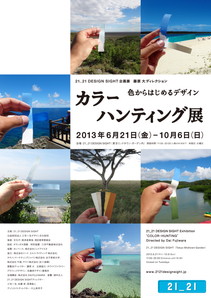
"Color-hunting" exhibition
An exhibition exploring the colors found in nature and in cities. On display were colored papers replicating natural and man-made tones. Results of collaborative studies made with researchers and companies on the theme of color and design were also shown. Dai Fujiwara was director for this exhibition which was held June-October 2013 at 21_21 DESIGN SIGHT.
I feel that we need such recycling-oriented projects to change people's awareness about cleaning up. You can't tell people what to do, so it's important to set up a system that will motivate them and get them involved perhaps on a daily basis in the streets or when they go on holiday somewhere. In Roppongi, maybe you could have an event where people come dressed in checkered clothes and clean up the streets. You could create a story for that. Perhaps you could make paper from the waste that is collected and sell it as "Roppongi Paper."
The distinctive colors of each area
As for the future of the Roppongi area, I think light tones instead of dark colors should be used for even small things like tiles, although they are expensive. (laughs) When you use light tones, the streets look brighter even when there are no street lights, and crime will probably decrease. I think that beige that is similar to the color of skin looks elegant and enhances the appearance of streets.
Incidentally, do you know where colors ultimately fall? They fall on the ground - on the roads and pathways. A while ago, I went to Paris on a color-hunting visit and found that there are many buildings in light colors. The surrounding scenery and the sky above and the colors of the walls are all reflected on the roads. Whether made from asphalt or cobblestones, the roads reflect the colors and look lovely. In Japan, too, each area has its own colors. Ginza and Roppongi have their distinctive colors. Maybe we should have today's photo shoot on a road in Roppongi.
Editor's thoughts
Fujiwara-san gave us plenty of ideas to think about. The photo shoot for this article was held near Tokyo Midtown West intersection. Before the interview, Fujiwara-san had walked around Roppongi looking for a suitable place to take photos. He told us that the colors he found in the area around this intersection were particularly pleasant.
(edit_kentaro inoue)




